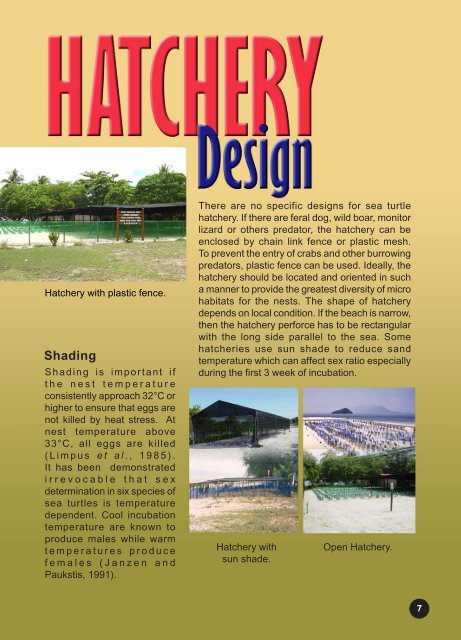Sea Turtle Hatchery - seafdec.org.my
Sea Turtle Hatchery - seafdec.org.my
Sea Turtle Hatchery - seafdec.org.my
Create successful ePaper yourself
Turn your PDF publications into a flip-book with our unique Google optimized e-Paper software.
<strong>Hatchery</strong> with plastic fence.<br />
Shading<br />
Shading is important if<br />
the nest temperature<br />
consistently approach 32°C or<br />
higher to ensure that eggs are<br />
not killed by heat stress. At<br />
nest temperature above<br />
33°C, all eggs are killed<br />
(Limpus et al., 1985).<br />
It has been demonstrated<br />
irrevocable that sex<br />
determination in six species of<br />
sea turtles is temperature<br />
dependent. Cool incubation<br />
temperature are known to<br />
produce males while warm<br />
temperatures produce<br />
females (Janzen and<br />
Paukstis, 1991).<br />
There are no specific designs for sea turtle<br />
hatchery. If there are feral dog, wild boar, monitor<br />
lizard or others predator, the hatchery can be<br />
enclosed by chain link fence or plastic mesh.<br />
To prevent the entry of crabs and other burrowing<br />
predators, plastic fence can be used. Ideally, the<br />
hatchery should be located and oriented in such<br />
a manner to provide the greatest diversity of micro<br />
habitats for the nests. The shape of hatchery<br />
depends on local condition. If the beach is narrow,<br />
then the hatchery perforce has to be rectangular<br />
with the long side parallel to the sea. Some<br />
hatcheries use sun shade to reduce sand<br />
temperature which can affect sex ratio especially<br />
during the first 3 week of incubation.<br />
<strong>Hatchery</strong> with<br />
sun shade.<br />
Open <strong>Hatchery</strong>.<br />
7

















